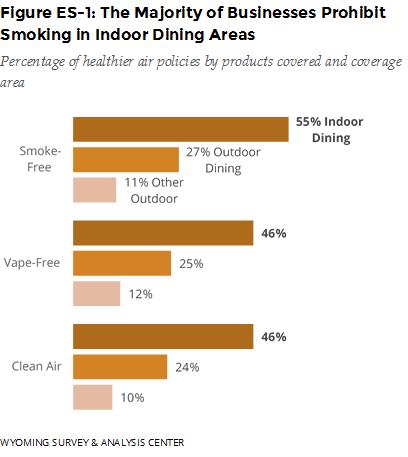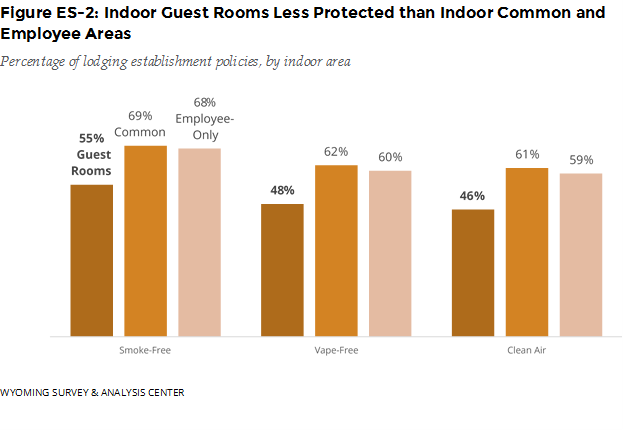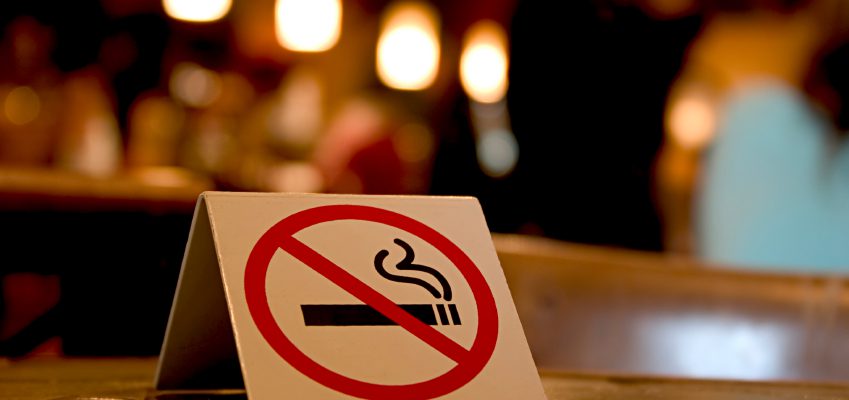Executive Summary
 The Wyoming Tobacco Prevention and Control Program (TPCP) shares a goal with the federal tobacco prevention and control program: decrease exposure to secondhand smoke (Starr, et al., 2005). According to the Surgeon General (U.S. Department of Health and Human Services [USDHHS], 2014) and the Centers for Disease Control and Prevention (CDC, 2014), smoke-free air policies improve public health by reducing exposure to secondhand smoke. The National Institute for Occupational Safety and Health (NIOSH, 2015) recommends that all employers establish written policies that prohibit smoking and vaping (the use of electronic nicotine delivery systems [ENDS]) in all indoor areas of their businesses to protect the health of their employees.
The Wyoming Tobacco Prevention and Control Program (TPCP) shares a goal with the federal tobacco prevention and control program: decrease exposure to secondhand smoke (Starr, et al., 2005). According to the Surgeon General (U.S. Department of Health and Human Services [USDHHS], 2014) and the Centers for Disease Control and Prevention (CDC, 2014), smoke-free air policies improve public health by reducing exposure to secondhand smoke. The National Institute for Occupational Safety and Health (NIOSH, 2015) recommends that all employers establish written policies that prohibit smoking and vaping (the use of electronic nicotine delivery systems [ENDS]) in all indoor areas of their businesses to protect the health of their employees.
In 2016, the Wyoming Survey & Analysis Center (WYSAC) at the University of Wyoming, under contract to the Wyoming Tobacco Prevention and Control Program (TPCP) in the Wyoming Department of Health, conducted a survey of hospitality businesses across Wyoming to learn about their policies related to smoking and vaping.
Most dining businesses (all types of restaurants and bars) had written smoke-free indoor air policies that protect customers and employees from secondhand smoke in all indoor dining areas. Vape-free policies were less common. Policies in outdoor dining areas and other outdoor areas were even less common (Figure ES-1). Bars were less likely than other types of dining establishments to have written policies protecting their customers and employees from secondhand smoke and secondhand ENDS aerosol. It was rare for a dining business to have a vape-free air policy without also having a smoke-free air policy in place. Thus, vape-free policies were the limiting factor preventing businesses from having clean air (smoke-free and vape-free) policies. Overall, 55% of dining businesses (including bars) had policies protecting customers and employees from secondhand smoke.
 When lodging businesses had smoke-free, vape-free, or clean indoor air policies, they were most likely to apply to indoor common areas (e.g., lobbies) or employee-only areas. Allowing smoking or vaping in at least some guest rooms was a relatively common practice in Wyoming, although this concession is becoming less popular nationally. In 2016, 85% of hotels nationwide were smoke-free, including all guest rooms (American Hotel & Lodging Association, 2016).
When lodging businesses had smoke-free, vape-free, or clean indoor air policies, they were most likely to apply to indoor common areas (e.g., lobbies) or employee-only areas. Allowing smoking or vaping in at least some guest rooms was a relatively common practice in Wyoming, although this concession is becoming less popular nationally. In 2016, 85% of hotels nationwide were smoke-free, including all guest rooms (American Hotel & Lodging Association, 2016).
As with the dining businesses, smoke-free policies were more common than vape-free indoor air policies. Vape-free policies in the absence of smoke-free air policies were rare, meaning that vaping policies were the limiting factor for clean air policies (Figure ES-2).

